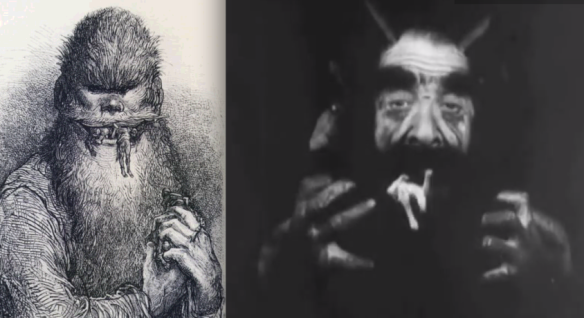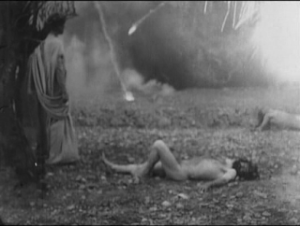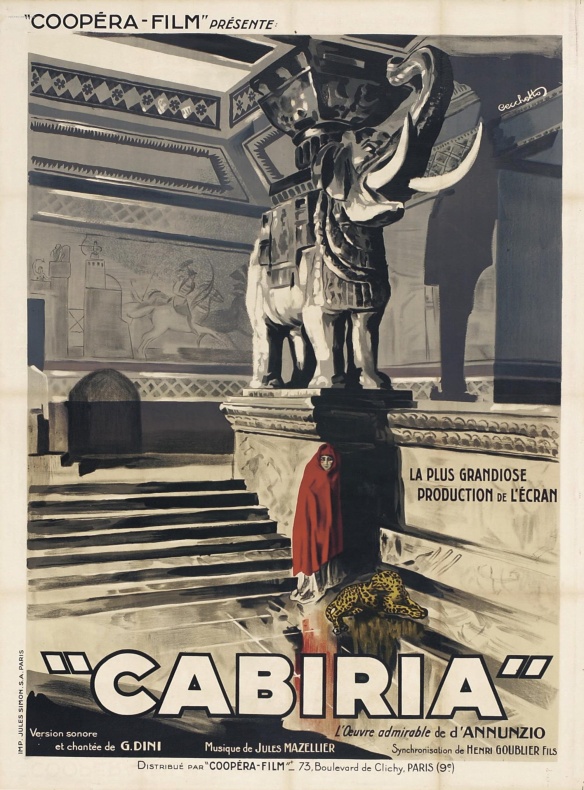Per E.M.A. Un’artista di talento e amica.
Traduzioni: Sara Trofa
L’Inferno (1911)

Locandina originale del film. Original Poster for the film
The American director D.W. Griffith is often credited as being the creator of the feature-length film. It was actually the Australians who made the first feature film in 1906 which was called The Story Of The Kelly Gang.
La creazione del lungometraggio viene spesso attribuita al regista americano D.W. Griffith ma di fatto furono gli australiani a realizzare il primo lungometraggio nel 1906 dal titolo The Story Of The Kelly Gang.
But in 1911 with the release of L’Inferno, the Italian industry created not only the first epic film but the first international blockbuster as well.
Nel 1911, con l’uscita de L’inferno, l’industria italiana creò non solo il primo film epico ma anche il primo film di successo internazionale.
Taking over three years to make, the film took in over 2 million dollars in the United States alone. As its extended length meant there could be less screenings per day, it gave the theater owners an excuse to raise the normal prices of admission. It remains the oldest feature film to still exist.
Esso richiese più di tre anni per la sua realizzazione ed incassò, solo negli Stati Uniti, più di due milioni di dollari. La lunghezza del film implicava meno proiezioni al giorno e i proprietari dei cinema ne approfittarono per aumentare il prezzo del normale biglietto. L’inferno resta il più vecchio lungometraggio esistente.
Credited to three different directors, the film is a live action adaptation of Dante’s Divine Comedy. The sets and visuals were closely based on Gustave Dorè’s engravings from his 1857 edition of the poets work which was, and still is, the most iconic representation of the title. Using fantastical, extravagant sets and special effects, the film must have been as terrifying to audiences in 1911 as any horror film of present day. Winged devils, brimstone hail, choking fires, it’s likely there were at least a few trips to the hospital by cast members who spent much time on the production. L’Inferno remains the oldest feature film to still exist.
Attribuito a tre registi, il film è un adattamento animato della Divina Commedia di Dante. Gli elementi scenici furono basati principalmente sulle incisioni di Gustave Doré dell’edizione del 1857, le quali ancora oggi sono la rappresentazione più iconica della Commedia. Considerati i fantastici e stravaganti set ed effetti speciali impiegati, il film dev’essere stato per il pubblico del 1911 tanto terrificante quanto lo è per noi oggi un qualunque film dell’orrore. Con diavoli alati, grandine di zolfo e fuochi soffocanti sul set, è probabile che i membri del cast impegnati nella produzione siano finiti all’ospedale almeno un paio di volte. L’Inferno resta il più vecchio lungometraggio esistente.

A sinistra, una illustrazione di Doré. A destra, il ritratto di Lucifero nel film. Left, one of Dorè’s illustrations, on the right, Lucifer’s depiction in the film.
Cabiria (1916)
It would be the feature Cabiria five years later that would be the most influential silent Italian film of the period. Directed by Giovanne Pastrone, the film was shot in Torino (Turin) and featured massive period sets as well as elaborate and imaginative miniatures which recreated the eruptions of Mt Etna in Sicily. It follows the story of a young girl, Cabiria, who is saved from the disaster caused by the eruption only to be captured by Phoenicians and sold into slavery in Carthage.
Cinque anni dopo, il film Cabiria fu il più influente film muto del periodo. Diretto da Giovanni Pastrone, il film fu girato a Torino con imponenti scenografie d’epoca ed elaborate e immaginifiche miniature che ricreavano l’eruzione dell’Etna in Sicilia. Ne derivò la storia di una ragazza, Cabiria, che viene salvata dal disastro dell’eruzione solo dopo essere stata catturata dai Fenici e venduta come schiava a Cartagine.

Primo piano della miniatura dell’eruzione dell’Etna. Foreground miniature of the eruption of Mt. Etna
The sets include a massive exterior and interior of the Temple of Moloch which includes a huge bronze statue of the god. During the sacrifice scene, the chest of the statue opens and dozens of children are thrown into its fiery belly one at a time, it’s mouth belching fire as the door swings shut on each sacrifice.
Il set includeva una riproduzione esterna ed interna del Tempio di Moloch con una enorme statua di bronzo raffigurante la divinità. Durante la scena del sacrificio, il petto della statua si apre, dozzine di bambini vengono gettati nella sua pancia infuocata tutti in una volta e un fuoco scoppia al richiudersi della porta dopo ogni sacrificio.
In one scene, the Roman navy assaults the city of Syracuse, a massive set and staged battle that would presage the scenes of the siege of Babylon years later in D.W. Griffiths’ Intolerance. While Pastrone’s film doesn’t have the same intercutting as Griffith’s, many of the lighting effects are much more dramatic than Grifffith’s.
In una scena, la flotta romana assalta la città di Siracusa, un imponente set con una battaglia di scena che presagisce le scene dell’assedio di Babilonia anni dopo in Intolerance di D.W. Griffith. Il film di Pastrone non ha lo stesso montaggio incrociato del film di Griffith, ma parecchi dei suoi effetti di luce sono molto più drammatici rispetto a quest’ultimo.
Pastrone would be the first to put a camera on a dolly and execute the long, slow tracking shots throughout the film that would be so influential to every feature afterwards. In fact for many years any dolly shot or one involving movement was known as a ‘Cabiria shot’. The film was also the first to incorporate flashbacks as a story device.
Pastrone fu il primo a mettere una videocamera su un dolly ed eseguire nel film quelle lunghe e lente carrellate che sarebbero poi state così rilevanti per ogni film successivo ed è per questo che per molti anni qualunque ripresa con un dolly o in movimento veniva chiamata ‘ripresa Cabiria’ (‘Cabiria shot’). Cabiria fu anche il primo film ad incorporare il flashback come espediente narrativo.
The film’s elephants made a huge visual impact on Griffith, and he would insist there be plaster elephant sculptures in the Babylon sets for Intolerance, despite the art department’s insistence that elephants did not exist in ancient Babylonia.
Gli elefanti nel film furono di così grande impatto visivo su Griffith che egli volle avere a tutti i costi degli elefanti di gesso sul set di Babilonia per Intolerance, nonostante l’insistenza del dipartimento artistico sul fatto che non esistessero elefanti nell’antica Babilonia.
Cabiria would be the first film to be screened at the White House by then President Woodrow Wilson in 1914.
Cabiria fu il primo film ad essere proiettato alla Casa Bianca dall’allora presidente Wilson Woodrow nel 1914.
While the films may be be very dated to our 21st century eyes, you can’t help but be impressed with the scale of the sets of these pre-computer age features.
Il film potrà essere datato ai nostri occhi del XXI secolo ma è ancora impossibile non restare impressionati dalla portata dei set di questo film precedente all’era dei computer.










